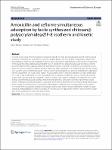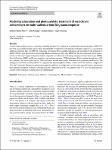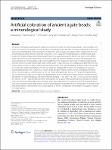Search
Author
- Amooey, Ali Akbar (1)
- Asmaa A. H., El-Bassuony (1)
- H. K., Abdelsalam (1)
- Heba, Kandil (1)
- next >
Subject
Date issued
- 2023 (5)
Has File(s)
- true (5)
Search Results
In this study, a highly effective hybrid adsorbent composite based on low-cost fuller’s earth (FE), aluminum silicate (AS) and chitosan (CS) was prepared using a facile method. The prepared composite was applied to adsorb lead (Pb2+) and copper (Cu2+) ions from aqueous solutions. Several analyses such as Fourier transform infrared spectroscopy (FTIR), Scanning electron microscopy (SEM) and X-ray diffraction (XRD) were used to characterize the composite. The adsorption efficiency of the prepared composite was investigated at different operating conditions. Moreover, the adsorption isotherm/kinetic models and adsorption thermodynamics of the composite were examined. |
In this work, Ag0.5Cr2.5O4 nanochromite is fabricated utilizing a simple process (flash technique) at various annealing temperatures (room and 900 °C). The particle sizes of the materials under study were shown to be in the nanoscale range by atomic force microscopy (AFM) and field emission scanning electron microscopy (FESEM). Fourier transform infrared (FTIR) analysis was performed to verify the fabrication of the examined nanosamples and evaluate the bands behavior. The tetrahedral A-site (622.9 cm−1 for room temperature, 630.6 cm−1 for 900 °C) and the octahedral B-site (557.3 cm−1 for room temperature, 563.1 cm−1 for 900 °C) were the two prominent bands measured by FTIR analysis. The elastic characteristics of Ag0.5Cr2.5O4 nanoparticles were examined using FTIR measurements, rev... |
In recent years, taking medicine has been increasing around the world due to population growth and the spread of disease. Antibiotics as a kind of these medicines include about 10 to 15% of drug consumption. Studies show that antibiotics, which are not completely removed, have a permanent and destructive effect on the environment. In this study, the chitosan@polyacrylamide@ZIF-8 as an adsorbent was simultaneously used to remove cefixime and amoxicillin from the aqueous solution by adsorption methods. XRD and FTIR patterns were analyzed to investigate the surface crystallinity and the chemical properties of the adsorbent. In the following, SEM and TEM images were used for surface morphology study. Finally, a numerical investigation was done for predicting the adsorption effective par... |
A nanocomposite photocatalyst consisting of titanium dioxide (TiO2) supported on multiwalled carbon nanotubes (MWCNTs) has been successfully prepared and used for the treatment of wastewater contaminated with tetracycline (TC), a recalcitrant antibiotic pollutant. The TiO2/MCNT composites were prepared by a simple evaporation-drying method. The properties of MWCNT/TiO2 were optimized by dispersing different amounts of TiO2 onto MWCNT. The structural and optical characteristics of the nano-engineered photocatalyst composite were characterized using scanning electron microscopy (SEM), X-ray diffraction (XRD), and Fourier-transform infrared spectroscopy (FTIR) techniques. Photocatalytic degradation of TC was conducted in a quartz glass reactor. |
The process of staining was frequently employed to enhance or alter the color of agate beads in ancient times. One of the key challenges in studying ancient beads is comprehending the intricate techniques employed to color agate stones. An understanding of the staining mechanism from a mineralogical standpoint offers insights into the level of technological advancement in different civilizations. In this study, the mineral structure of eight ancient agate beads from Xinjiang Uygur Autonomous Region, NW China, was analyzed using Micro X-ray fluorescence (µXRF), Raman spectroscopy, Scanning Electron Microscope (SEM), and Fourier Transform Infrared (FTIR) techniques. The color, transparency, mineral phase, and surface roughness of the beads were examined, revealing variations ranging f... |





